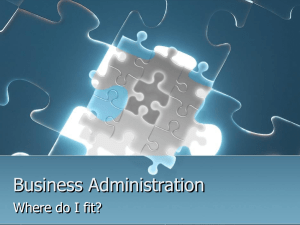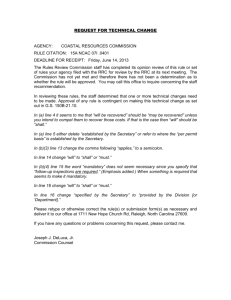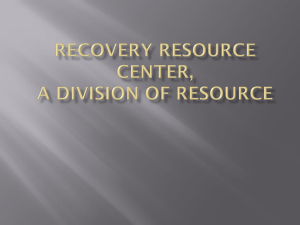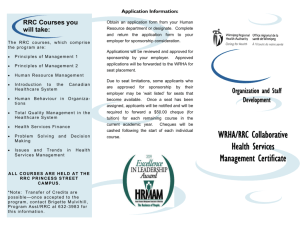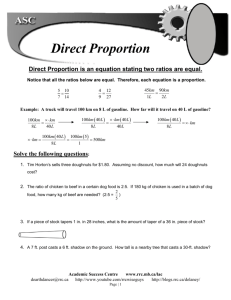Goho_Knowledge Management
advertisement
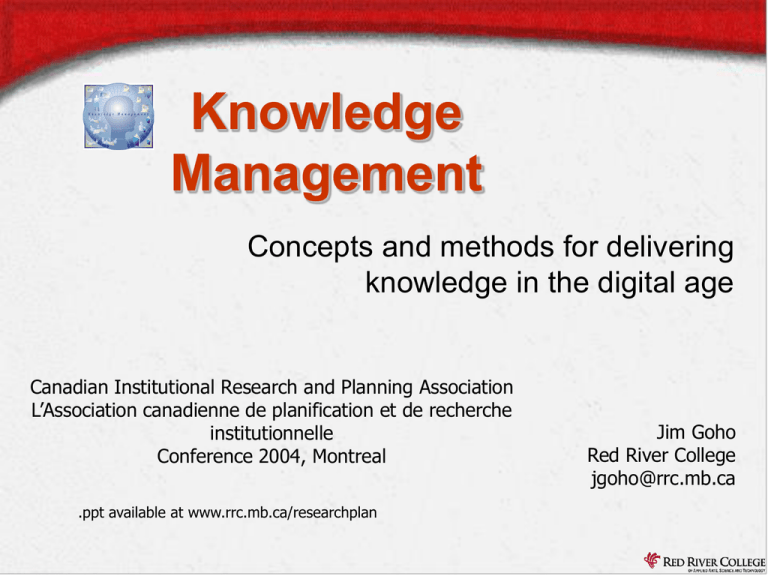
Knowledge Management Concepts and methods for delivering knowledge in the digital age Canadian Institutional Research and Planning Association L’Association canadienne de planification et de recherche institutionnelle Conference 2004, Montreal .ppt available at www.rrc.mb.ca/researchplan Jim Goho Red River College jgoho@rrc.mb.ca Objectives for this session • To explore the concepts & theory of Knowledge Management (KM) • To learn about some KM programs • To discuss the idea of KM in Postsecondary Education and in IR • To identify some of the controversies around KM Knowledge Management © United Features Syndicate, Inc. What is Knowledge Management? • Defined in a variety of ways. • KM in education: a strategy to enable people to develop a set of practices to create, capture, share & use knowledge to advance. • KM focuses on: • people who create and use knowledge. • processes and technologies by which knowledge is created, maintained and accessed. • artifacts in which knowledge is stored (manuals, databases, intranets, books, heads). Sources: Petrides, L.A. & Nodine, T.R (2003). Knowledge management in education: Defining the landscape. Edvinsson, L. & Malone, M.S. (1997). Intellectual capital: Realizing your company's true value by finding its hidden brainpower . Ford, N. (1989). From information- to knowledge-management. Journal of Information Science Principles & Practice. What is Knowledge Management? “Knowledge management is a discipline that promotes an integrated approach to identifying, managing and sharing all of an enterprise’s information needs. These information assets may include databases, documents, policies and procedures as well as previously unarticulated expertise and experience resident in individual workers.” Source: GartnerGroup Research. A Community College’s Definition “A discipline and framework designed to help our organization acquire, package and share “what we know” to enable decision-making, creativity, innovation and communication.” (Cuyahoga Community College) Where does KM come from? • Technology • Infrastructure, Database, Web, Interface • Globalization • World wide markets, North American integration • Demographics • Aging population, workforce mobility, diversity • Economics • Knowledge economy • Customer relations • Quality • Increase in information • Specialization, Volume, Order Sources: Brown J.S. & Duguid, P. (1991). Organisational learning and communities-of-practice. Organisational Science. .O’Dell C. & Grayson Jr., C.J. (1998). If only we knew what we know. Stewart, T. (2002). The wealth of knowledge. The Rise of the Knowledge Worker 100% 90% 80% 70% 60% 50% 40% 30% 20% 10% 0% 1900 1910 1920 1930 farmworkers service managerial & admin. Source: Stewart T.A. (1997). Intellectual capital. 1940 1950 1960 labourers & operators clerical prof. & tech. 1970 1980 crafts sales 1990 2000 Labour market employment shift to a knowledge economy Average annual rate of growth in Canadian labour market sectors (%) 1971-1996 2.1 Overall 0.6 Production 2.6 Services 2.2 Data 7.6 Management 4.1 Knowledge 0 2 4 Source: Lavoie, M. & Roy, R. (1998). Employment in the knowledge-based economy. 6 8 Digital Students By age 21, the average college student will have spent: • • • • • 10,000 hours video games 200,000 emails 20,000 hours TV 10,000 hours cell phone Under 5,000 hours reading Source: F. Prochaska, Students and Faculty Today: Inhabiting the Evolving Universe of Teaching, Learning, and Technology, 2003. Why KM? Source: Luan, J & Serban, A. (2002, June). Knowledge management concepts, models and applications. Paper presented at Annual AIR Forum, Toronto. What is Knowledge? • Knowledge is justified true belief. Ayer, A.J. (1956). The Problem of Knowledge. • Knowledge is a fluid mix of framed experience, values, contextual information and expert insight that provides a framework for evaluating and incorporating new experience and information. It originates and is applied in the minds of knowers. In organizations it often becomes embedded not only in documents or repositories but also in organizational processes, practices and norms. Davenport, T.H. & Prusak, L (1998). Working Knowledge. • Knowledge is information in action. O’Dell C. & Grayson Jr., C.J. (1998). If only we knew what we know. Data, Information & Knowledge Definition Reason DATA INFORMATION KNOWLEDGE Raw facts, figures and records contained in a system. Data placed into a form that is accessible, timely and accurate. Processing Storing / Accessing. Information in context to make it insightful and relevant for human action. Insight, innovation, improvement. Source: Luan, J & Serban, A. (2002, June). Knowledge management concepts, models and applications. Paper presented at Annual AIR Forum, Toronto. "We are drowning in information but starved for knowledge" Naisbitt , J. (1984) Megatrends: Ten new directions transforming our lives. Two types of knowledge Documented information that can facilitate action. Explicit knowledge • Formal or codified • Documents: reports, policy manuals, white papers, standard procedures • Databases • Books, magazines, journals (library) Know-how & learning embedded within the minds people. Implicit (Tacit) knowledge • Informal and uncodified • Values, perspectives & culture • Knowledge in heads • Memories of staff, suppliers and vendors Knowledge informs decisions and actions. Sources: Polanyi, M. (1967). The tacit dimension. Leonard, D. & Sensiper, S. (1998). The Role of Tacit Knowledge in Group Innovation. California Management Review. Layers of knowledge Explicit Implicit (Tacit) In people’s heads. Individual • Undocumented ways of working in teams, teaching. Organizational • Cultural conventions known and followed but not formalized. Source: Luan, J & Serban, A. (2002, June). Knowledge management concepts, models and applications. Paper presented at Annual AIR Forum, Toronto. Personal documents on my C:\ • Formalized process for developing curriculum. • Corporate polices and procedures. In the Business World • KM is becoming a “big deal” in industry. • KM involves collaboration, organizational learning, best practices, workflow, IP management, document management, customer focus and using data meaningfully [data mining]. • KM requires understanding the soft skills necessary to work with people. Source: Clare Hart, President and CEO Factiva, Knowledge Management London 4 April 2001 What are USA companies doing? 0% 20% 40% 60% 80% 100% Capture & share best practices Corporate learning strategies CRM Competitive intelligence [Source: Milan, J. (2001) KM: A revolution waiting for IR. Paper presented at the 41st Annual AIR Forum.] 81% of businesses with KM solutions see productivity improvements. [Malhotra, Y. (2001). If Statistics Canada Measures KM It Must Exist. Proportion of firms with dedicated spending on KM practices 2,000 & more workers 500-1,999 workers 250-499 workers 50-249 workers Less than 50 workers 0% Source: Statistics Canada. (2002) Are we managing our knowledge? 10% 20% 30% 40% 50% 60% What are organizations doing in Canada? 1. Knowledge capture and acquisition • E.g., environmental scanning. 2. Developing strategies for implicit K sharing: • E.g., CoPs, virtual teams, list of experts & mentoring. 3. Using technologies to store, analyze & distribute explicit K. • Corporate portals, business K base, process control inventories, CRM. Source: Statistics Canada. (2002) Are we managing our knowledge? Relevance to PSE • Not on the agenda of most (Kidwell, Vander Linde & Johnson, 2000). • However, universities and colleges are in the knowledge business. • Many have KM organizational initiatives (e.g., Washington State Univ., Jackson State Univ., Santa Barbara City College, Cuyahoga Community College) • Some use technology • and some offer KM education. • George Mason, Dominican Univ., Univ. of Washington, RRC Technology Components of a KM Solution • • • • • Portals Websites Search Engines Shared Drives Specialty Knowledge Applications • Share Point • FAQ and Lessons Learned • Online survey tool • Knowledge and Information Tools Campus Web Portals (2003 National Survey of IT in US Higher Education) 28% of institutions have web-based campus portals (21% in 2002) Source: Green, K.C. The Campus Computing Project Web Portals An electronic gateway to a comprehensive pool of information and services that is organized and presented to serve the needs of a defined user population. Source: Green, K.C. The Campus Computing Project Characteristics of Web Portals • Visual appeal; ease of navigation • Organized around user’s information and transaction needs • Is customized by system to meet user’s needs and convenience • May be personalized by user to meet user’s preferences Source: Green, K.C. The Campus Computing Project What’s KM in IR? • • • • • Information authority. Spin doctor. Policy wonk. Scholar & researcher. Manager of knowledge. Source: Serban, A.M. (2002). KM: The fifth face of IR. Illustrated KM Models Tiered Knowledge Management Model (TKMM) in Institutional Research Tiers: Tiers: three two one Data Mining Classical multivariate statistics Querying OLAP Data Warehouses Enterprise Resource Planning (ERP) Explicit Knowledge Knowledge Base Knowledge Workers Portals CRM one Collaborative Working Environment (CWE) Knowledge Mapping three Tacit Knowledge Source: Luan J. & Serban A.M. , (2002). KM: Building a competitive advantage in higher education. two KM at RRC • • • • • • Learning about KM. Knowledge capture & acquisition. Knowledge sharing. KM strategy. ConnectRRC! Continuing Education program. IR and KM • Documentation – data dictionary. • Enrolment management (forecasting model). • Academic curriculum renewal – program benchmarking – best practices. • Strategic planning. • Web deployment of IR. Environmental Scanning • Formalized annual scanning process. • Internal and external. • Tested against knowledge of College Board, leaders, faculty and staff. • Face to face • Web consultation. • Used to inform strategic and operational plans. • Vision, mission, values, goals, and objectives. www.rrc.mb.ca/researchplan Learner Management • Go from reporting what happened to why it happened to forecast what will happen. • Graduate outcomes • Employment – logistic and multinomial regression. • Earnings – linear regression. • Collapsing satisfaction questions – factor analysis. • Effectiveness of selection interviews – metaanalysis. • Goal – Forecast which prospective students will be consistent donors as alumni. ConnectRRC! • • • • Community of interests. Will build for the future. Start at the grassroots level. Bring together people who have an interest in KM. • Work together to connect and share. • Promote an understanding and use of KM. • Website: http://connect.rrc.mb.ca Source: George Siemens, RRC. Activities • Blogging/aggregation. • New model innovation built on the unique attributes of the Internet/ • Listserv. • Face to face forums. • Collaborate, e.g., RROC. Source: George Siemens, RRC. Other things - Sharepoint - small team collaboration already being used by several committees, connect, instructors, etc.. • Informal knowledge sharing • College-wide FAQs Source: George Siemens, RRC. KM Courses • • • • • Knowledge Management - An Overview . Organizational Culture – Adapting to Change. Knowledge Mapping an Organization. Training and Development. KM Process Management: • Creating, structuring, storing knowledge. • Retrieving, acquiring and using knowledge. KM is Nonsense • KM is a management consultant conspiracy (search and replace marketing). • KM practitioners don’t know what “knowledge” really is. • KM is the ‘Learning Organization’ rebranded. • KM cheerleaders misunderstand tacit knowledge (Polanyi’s sense). • KM is nothing new. Source: Wilson, T.D. (2002). The nonsense of ‘knowledge management.’ Information Research, 8(1). KM is here to stay KNOWLEDGE IS LIKE LIGHT. Weightless and intangible, it can easily travel the world, enlightening the lives of people everywhere. Yet billions of people still live in poverty unnecessarily. Knowledge about how to treat such a simple ailment as diarrhea has existed for centuries but millions of children continue to die from it because their parents do not know how to save them. Source: Opening statement of the World Bank 1998/99 World Development Report: Knowledge for Development. Human history becomes more and more a race between education and catastrophe. H.G. Wells.
